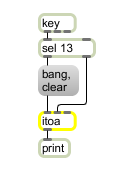Examples

Collect typed keys into a symbol (output with return key).
Convert integers to ASCII characters
| bang | In left inlet: a message can be used to trigger the output of the currently stored string of ascii characters as a symbol. | |
| int | input [int] |
In left inlet: The integer is interpreted as an ASCII character which is stored internally and sent out the outlet as a symbol. In middle inlet: The integer is interpreted as an ASCII character which is appended to the internally stored character string. No output is triggered. In right inlet: The integer is interpreted as an ASCII character which is stored internally, replacing the previously stored character string, but not output. |
| float | input [float] |
Converted to . |
| list | input [list] |
In left inlet: Each value in list of integers sent to the left inlet is interpreted as an ASCII character and stored internally as an ASCII character string, replacing the previously stored character string, and output as a symbol. In middle inlet: A list of integers sent to the middle inlet will be converted to ASCII characters and appended to the current internally-stored character string, without causing output. In right inlet: A list of integers sent to the right inlet will be converted to ASCII characters and stored internally as an ASCII character string, replacing the previously stored character string, without triggering output |
| clear | input [list] |
In left inlet: The message is used to clear the contents of the internally-stored string of ascii characters. |

| Name | Description |
|---|---|
| atoi | Convert ASCII characters to integers |
| key | Report key presses on the computer keyboard |
| keyup | Report key releases on the computer keyboard |
| message | Send any message |
| regexp | Use PERL-style regular expressions to process input |
| spell | Convert input to ASCII codes |
| sprintf | Format a message of words and numbers |
| Max Basic Tutorial 8: Keyboard and Mouse Input | Max Basic Tutorial 8: Keyboard and Mouse Input |
| Max Comm Tutorial 2: Serial Communication | Max Comm Tutorial 2: Serial Communication |